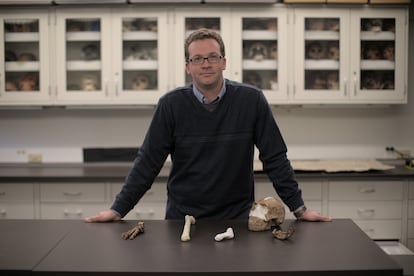Jeremy DeSilva, anthropologist: ‘Empathy and compassion compensated for the physical disadvantages of bipedalism’
The American researcher talks to EL PAÍS about how walking upright was the starting point for our brain enlargement and our pro-social nature

In the course of a lifetime, the average person takes about 150 million steps — enough to circle the Earth three times. We may not realize it, but our ability to walk upright is a rare phenomenon in nature, unique among mammals. Anthropologist Jeremy DeSilva, 48, has dedicated his career to studying human evolution through the lens of bipedalism. He is part of the research team that discovered two ancient members of the human family: Australopithecus sediba and Homo naledi. He has also studied wild chimpanzees in western Uganda and early fossils in museums in eastern and southern Africa. All in pursuit of one question: how did walking upright make us human?
DeSilva has sought answers everywhere. His studies of ancient feet have reconstructed the locomotion of early apes and our hominid ancestors. In his book, First Steps: How Walking Upright Made Us Human, DeSilva combines history, science, and culture to explore how bipedalism shaped humanity and helped us become the dominant species on Earth. Speaking to EL PAÍS via video call from his office at Dartmouth College, DeSilva remained standing throughout the entire interview.
Question. Do you usually spend a lot of time standing?
Answer. As a scientist, you’re supposed to be as objective as possible, collect your data and observe it from a distance. But the reality is that science is done by scientists, and scientists are human. The questions we ask influence us, too. I’ve been studying this topic, and since I wrote the book, I make sure I walk every day. I try to stay active. I use a standing desk, like the one I have now, rather than sitting. Although there’s recent data showing that it’s not that beneficial.
Q. Throughout your career as an anthropologist, you have asked many questions about our extinct human ancestors. Why did you end up choosing to study upright walking?
A. As an anthropologist, I am interested in unusual aspects of humans. One of them is the bipedal form of locomotion: we are the only mammal on the planet that habitually walks on two legs. And we have been doing so for a long time. From the fossil record, we can say that walking upright was one of the earliest adaptations that made us human beings.
Q. You have focused on the morphology of the feet. Is that the key to understanding bipedal walking?
A. Partly yes. I find feet fascinating because each foot is made up of 26 individual bones, 52 bones total. That’s a quarter of the bones in your body. These pieces interact with each other to provide a structure that’s stiff enough to push the body off the ground, but compliant enough to also absorb force. Bipedal walking is a wonderful place to interrogate questions about our origins and evolution.
Q. Why do you claim that walking upright made us human?
A. Walking on two legs laid the groundwork for everything that came after in our evolutionary history: bigger brains, the freeing up of hands for tool construction, changes in the torso and waist that led to finely controlled breathing that allowed us to speak and create language. All of these things that we celebrate and know are uniquely human would not have happened if it weren’t for this unusual form of locomotion. Bipedalism makes us human because it was the starting point.
Q. Why is bipedalism so unusual among mammals?
A. Because it makes you slow and vulnerable to predators.
Q. That’s an evolutionary disadvantage, how did humans manage to thrive?
A. We don’t know. There’s a lot about the evolution of bipedalism that we’re still trying to figure out. We’re going to need more fossils to really understand it and answer that question. However, one of my favorite things that we’ve discovered in the fossil record is evidence of healed injuries to the feet and the leg. Some of our ancestors broke their ankles or femurs, and it didn’t lead to their death. Instead, they healed and survived.
Q. What is the advantage of upright walking?
A. The fact that bipedalism makes us so vulnerable, and that we have evidence of individuals who survived some of these injuries, is a good evidence that this form of walking also coincided with social evolution. Let me explain: millions of years ago, if you broke your ankle you couldn’t walk, and you were more likely to die, but someone took care of those injured people so that they survived. It is one of the first displays of compassion and empathy for others, something that ended up becoming one of our main social characteristics. The fact that we take care of each other when we are injured may also have been born out of that vulnerability that upright walking brought. Caring, empathy and compassion are evolutionary advantages that compensated for the physical disadvantages of bipedalism.
Q. Walking upright triggered many changes in the anatomy and behavior of our ancestors, which would you say were the most decisive?
A. The first hominids to walk on two legs lived in Africa seven million years ago. Behaviorally, they appear to be quite ape-like. As we get to Australopithecus, the group made famous by Lucy, bipedalism became the standard form of locomotion. It’s no coincidence that during that time their brains increased by 20% in size compared to that of chimpanzees.
Q. So walking on two feet helped our brains get bigger over time?
A. Brains are very energetically expensive to grow. So where does the energy that increased their size come from? Moving on two legs is actually an energetically very efficient way to move. We don’t use much energy, and the rest can go to other tissues in the body, including the brain, which ends up increasing its size. Then the system was optimized. A more efficient form of bipedalism developed in the genus Homo. Changes in the feet and legs allowed us to navigate over a larger area and find more food. Eventually, we spread so much — thanks to walking on two feet — that we became a global lineage.
Q. You mentioned Lucy — this month marks 50 years since her discovery. Did the discovery of this Australopithecus change our idea of locomotion among early hominids?
A. Yes, absolutely. Lucy was so important and remains incredibly important for science. She was the final piece of evidence to solidify the hypothesis that upright walking precedes significant brain enlargement. With Lucy, you have a hominid with a relatively small brain, but with a pelvis, knees, ankles and lower back that have all the hallmarks of someone who can walk on two legs.
Q. Modern humans have inherited a body design that originated when we lived a very different way of life. What role does walking play in a world where we have cars, bicycles, escalators and elevators?
A. There is very good evidence that walking is still incredibly good for us. As humans, we are constantly searching for a magic pill that will give us health and longevity. We have it: taking a daily walk. It’s as simple as that. Walking reduces the risk of cardiovascular disease, stroke, and developing diabetes. Walking is good for brain health. It helps with memory and creativity. It wards off certain cancers.
Q. We should walk more.
A. My recommendation is that if you are physically able to walk up the stairs, rather than using the elevator, do so. If you can have a meeting standing up, try to do that instead of sitting around a table. The more we can move our bodies, the healthier we will be. Think of it this way: in our early days, if you wanted to get food, you had to go out and find it, walk around your environment. There are groups in Tanzania, South America, and Southeast Asia that are still hunter-gatherers. Often, these populations don’t suffer from comes of what we call diseases of modernity. What has happened in our modern lifestyle is that we stopped walking. In terms of health, I think the consequences are very visible.
Q. Are there any aspects of the development of bipedal locomotion that are still a mystery or under debate in the scientific community?
A. Yes, the most important questions remain unanswered. The main one is why and how it started. What actually allowed our ancestors to move this way and not be eaten by predators in their environment? That’s what we’re still struggling to figure out. We also want to know what were the advantages it brought. Some scientists have argued that one of the main benefits, besides the empathy I already mentioned, was food sharing. In bipedal locomotion, the hands were freed, which allowed them to gather more food and give it away to others. That sharing would have made for a healthier population. But these are just hypotheses, we’re still trying to figure out those questions.
Sign up for our weekly newsletter to get more English-language news coverage from EL PAÍS USA Edition
Tu suscripción se está usando en otro dispositivo
¿Quieres añadir otro usuario a tu suscripción?
Si continúas leyendo en este dispositivo, no se podrá leer en el otro.
FlechaTu suscripción se está usando en otro dispositivo y solo puedes acceder a EL PAÍS desde un dispositivo a la vez.
Si quieres compartir tu cuenta, cambia tu suscripción a la modalidad Premium, así podrás añadir otro usuario. Cada uno accederá con su propia cuenta de email, lo que os permitirá personalizar vuestra experiencia en EL PAÍS.
¿Tienes una suscripción de empresa? Accede aquí para contratar más cuentas.
En el caso de no saber quién está usando tu cuenta, te recomendamos cambiar tu contraseña aquí.
Si decides continuar compartiendo tu cuenta, este mensaje se mostrará en tu dispositivo y en el de la otra persona que está usando tu cuenta de forma indefinida, afectando a tu experiencia de lectura. Puedes consultar aquí los términos y condiciones de la suscripción digital.
More information
Archived In
Últimas noticias
EU’s prestige at stake with proposal to fund Ukrainian war effort with Russian assets
Mustafa Suleyman: ‘Controlling AI is the challenge of our time’
Venezuela breaks energy agreements with Trinidad and Tobago due to alleged complicity with the US
The murder of Michele and Rob Reiner: A tale of horrific days in Hollywood
Most viewed
- ‘El Limones’ and the growing union disguise of Mexican organized crime
- Christian Louboutin: ‘Young people don’t want to be like their parents. And if their parents wear sneakers, they’re going to look for something else’
- ‘We are dying’: Cuba sinks into a health crisis amid medicine shortages and misdiagnosis
- A mountaineer, accused of manslaughter for the death of his partner during a climb: He silenced his phone and refused a helicopter rescue
- The low-cost creative revolution: How technology is making art accessible to everyone









































